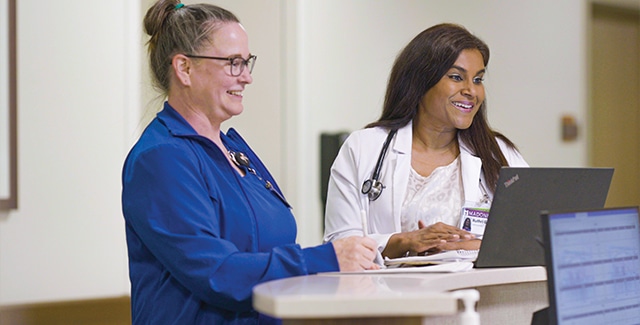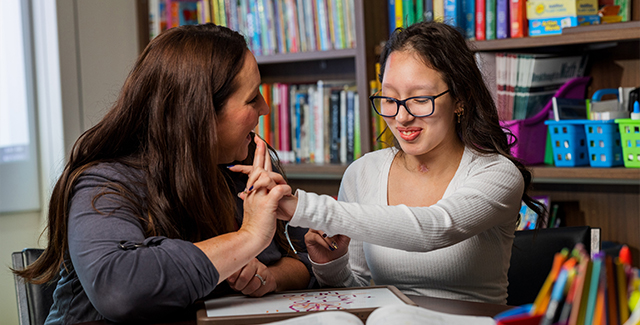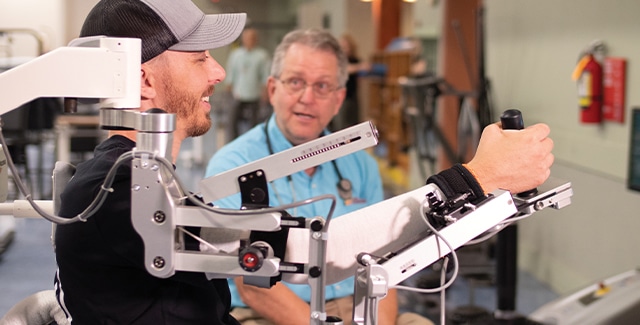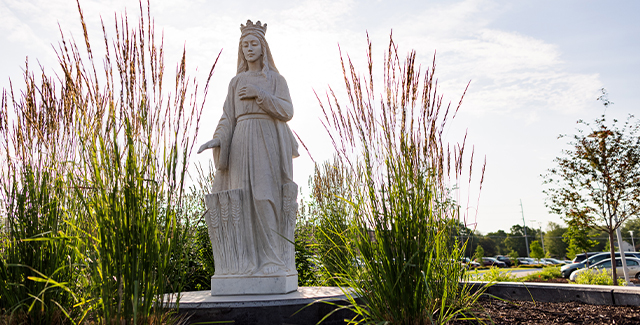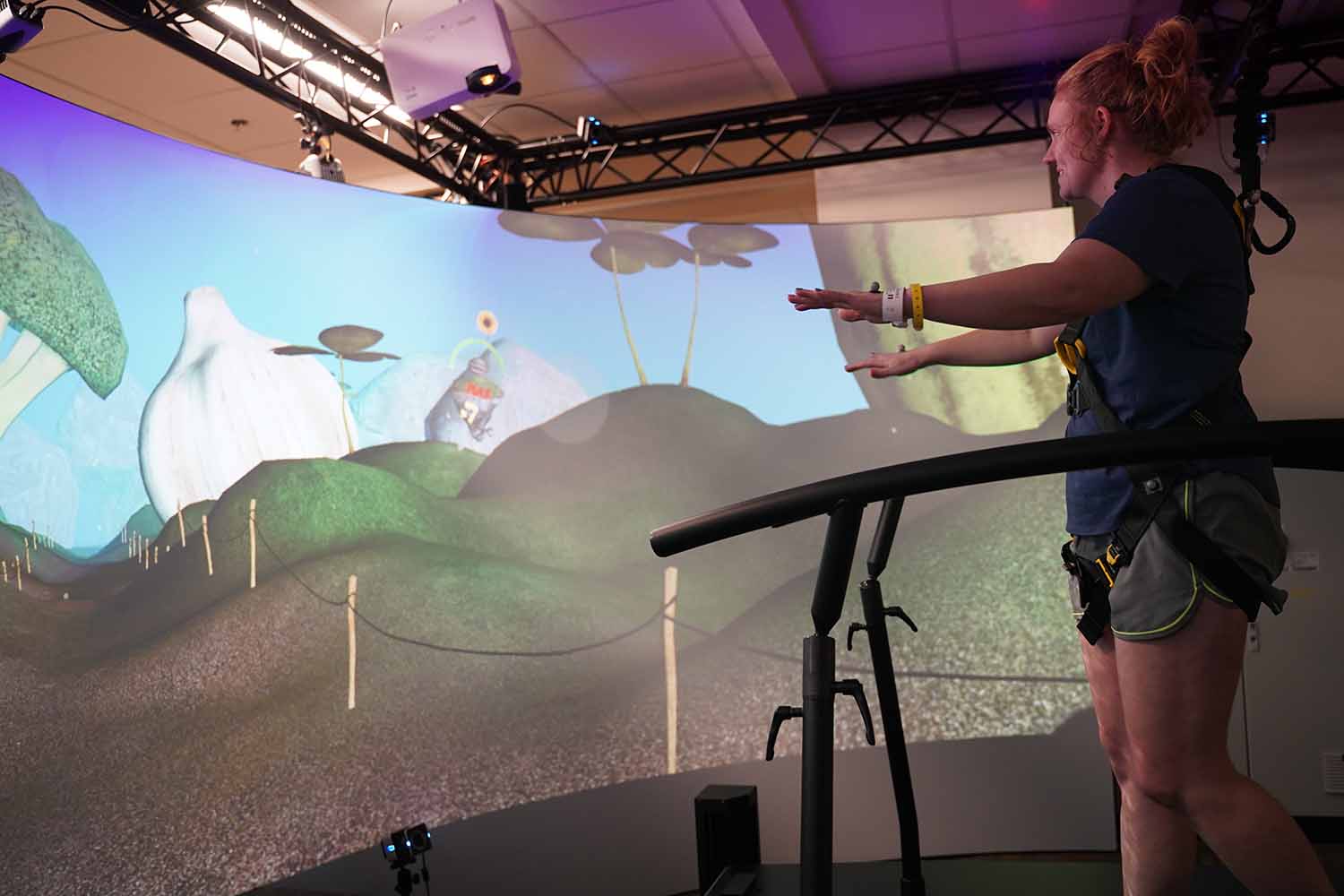As an avid runner, volleyball player and active mom of two, Katelyn Cortese is always on the move. A Guillain-Barré syndrome diagnosis at the beginning of April stopped her in her tracks. Symptoms of the rare neurological disorder started in March and became increasingly concerning for her.
“The last Saturday of March, I had tingling in my left foot,” Katelyn said. “Then, I had tingling in my right foot, and then I had tingling in both my hands. Sunday, I ended up having tingling around my mouth.”
After trips to three emergency rooms, Katelyn finally received her Guillain-Barré diagnosis at Nebraska Medicine. She spent 11 days there, as the tingling continued up her torso, and she started feeling extreme weakness in her arms and legs.
“I’ve never even heard of Guillain-Barré, so for something like this to happen, I was shocked and I was scared,” Katelyn said. “There were quite a few tears at Nebraska Medicine, but once I got to Madonna, I knew it was only up from here. I had no more worries. I just knew I had to work hard to get better.”
When Katelyn arrived at Madonna, she could stand for short periods, but couldn’t get to a standing position alone. She used a special lift to transfer around her room and a wheelchair for long distances. Still, Katelyn’s personality showed her care team they could push her right from the start.
“I remember the first time I asked her to stand, I said, ‘Hey, have you stood before?’” Bianka Alvarado Milla, OTR/L, Katelyn’s occupational therapist, said. “She said, ‘No, but I’m willing to try.’ We did just that, and at first, it wasn’t pretty, but she was always willing to try whatever we came up with.”
In her first physical therapy session with Jill Schott, PT, DPT, Katelyn stood in Madonna’s parallel bars. Later that day, Schott upped the challenge.
“I had an opening later in the day at the same time her occupational therapist, Bianka, was supposed to see her, and I said, ‘Let’s put her in the Solostep. Let’s see what she can do,’” Schott said.
The Solostep is Madonna’s newest piece of equipment, featuring a harness system that keeps a patient safe from falling as they take steps, but does not offer any bodyweight support.
“I was dragging my feet, my ankles were rolling, and I had both therapists under me, kind of supporting my arms, but I probably walked 40 feet that first time,” Katelyn said.
Katelyn filmed those first few steps on her phone and sent them to her husband, Joe, who says he was shocked to see her therapists pushing her so early in her recovery.
“I was here on her full first day, and she wasn’t walking, but I think it was literally the next day where they had her walking with the harness, and it was just mind-blowing,” Joe said.
In addition to weakness in her legs, Katelyn also dealt with ataxia, not having awareness of where her legs were in space, making walking difficult. Katelyn says she remembers feeling like she was walking on her tiptoes, and Schott reassuring her she had her feet firmly on the ground. In a matter of weeks, Katelyn was able to transition from using the LiteGait bodyweight support system and SoloStep to using a cane and finally taking unassisted steps. Her rapid recovery surprised her, but her therapists knew she was going to do great things.
“I knew Katelyn would make amazing progress when she was just always so willing to do anything that I asked her to do,” Alvarado said. “She would tell me, ‘Yesterday, I did this,’ and I’d say, ‘Ok, well today we’re going to take it up a notch and we’re going to do this.’ She wasn’t afraid of taking that extra step, and I think that’s what really pushed both of us to always strive for that next goal.”
Toward the end of her time as an inpatient at Madonna, Schott put Katelyn on the Motek GRAIL, a split-belt treadmill with a harness that has an immersive virtual reality screen, to give her an extra challenge for her balance and walking dynamics. Katelyn navigated a simulated rope bridge that would sway and tilt as she walked. She also guided a ship through an obstacle course by leaning to one side or the other.
Once Katelyn felt safe walking on her own, occupational therapy began to challenge her with everyday tasks she knew she wanted to return to, like cooking, cleaning and caring for her children. Using Madonna’s Independence Square, she could practice lifting a child out of a crib and onto a diaper-changing station, giving baths, carrying a car seat and even cleaning up toys from the floor.
“Given the fact that she was going back to her children, back to her spouse, she had something to look forward to going home,” Alvarado said. “Aside from the physical, you could just see in her face the excitement to be able to get back to those routines that she was doing prior, and to get back to being a homemaker and a mom. I could tell that she was so excited and motivated, and when it was time to go home, I felt like she was confident in herself and her ability to go back to those roles.”
As she returns home and continues therapy in Madonna’s outpatient Rehabilitation Day program, Katelyn says she’s setting her sights on a few lofty goals this summer, including returning to work and running a 10 K.
“For anyone who does go through Guillain-Barré, it’s scary, but most people recover, and everyone goes at their own pace. There is light at the end of the tunnel, and you just have to work for it,” Katelyn said.
Her husband Joe agrees.
“It was a journey, but as crummy as the situation was, it was a positive overall, with the getting better and the care here we have and everything,” he said. “We have such a huge and great supporting staff, and we made the best of it.”

